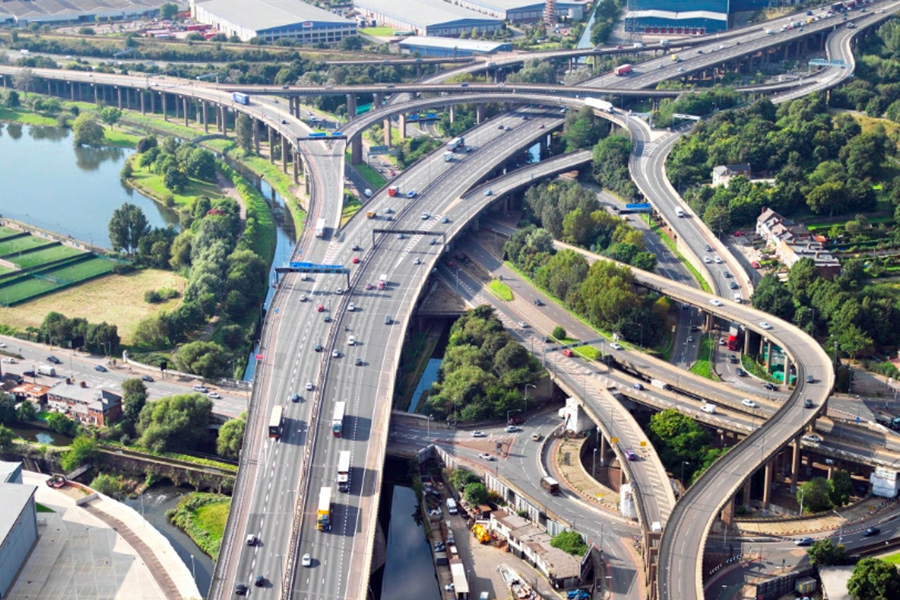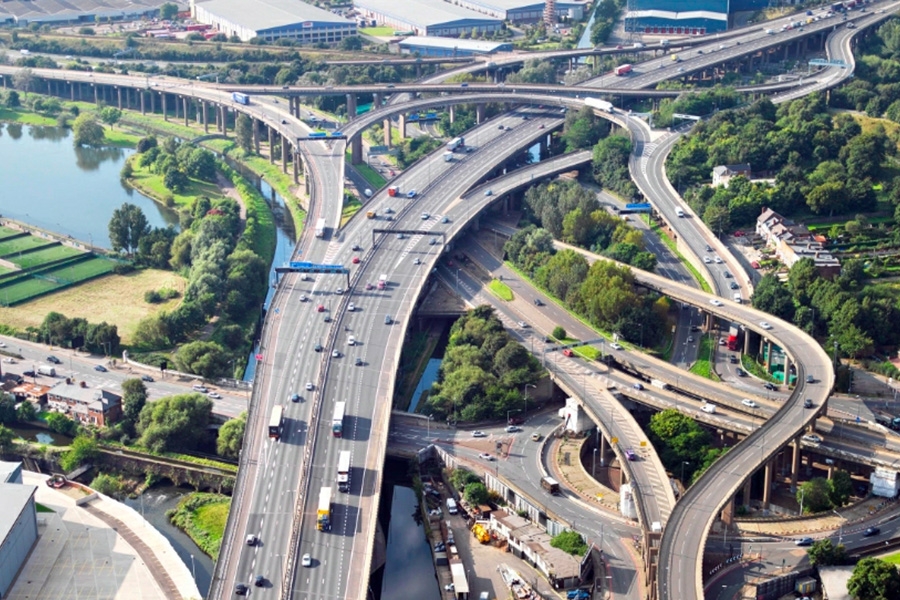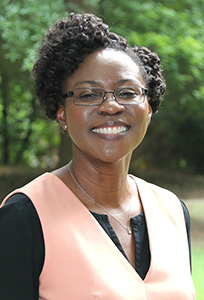 |
| Photo Credit: Original - Highways Agency photo on flickr, CC BY 2.0 via Wikimedia Commons |
A bipartisan group of senators has announced a $1.2 trillion infrastructure framework, which aims to make transformational investments in infrastructure for transportation, clean water, universal broadband, renewable energy, remediation of legacy pollution, and resilience to the changing climate.
Though the legislation still awaits debate in Congress and approval from President Joe Biden, it represents an important step toward addressing the nation’s infrastructure needs.
Faculty from the School of Civil and Environmental Engineering — experts in the infrastructure systems covered by the proposal — shared their perspectives on what should be prioritized to meet the future needs of the nation.
Transportation
|
|
“I’m excited to see attention being placed on upgrading our electric grid, which will be essential for not only supporting the expansion of electric ground vehicles, but also supporting the future introduction of a new class of battery-powered aircraft into the market.
These new aircraft, which are called electric vertical take-off and landing (or eVTOL) aircraft and are colloquially known as “flying cars,” are envisioned to carry four to six passengers up to 50 miles within our cities. These eVTOL aircraft could be used to fly over traffic congestion on the ground and transport passengers to work, the airport, or other locations. Investing in our power infrastructure helps ensure that we will be able to quickly recharge the batteries on these aircraft, which will in turn will help us more efficiently and reliably operate these aircraft and avoid delays.”
—Laurie Garrow, Professor
|
|
“My priorities would be to modernize and expand transit and rail networks and repair and rebuild roads and bridges with a focus on climate change mitigation, resilience, equity, and safety for all users, including cyclists and pedestrians.
Across the world, we have witnessed the positive impacts in other high-income countries as they have invested in modernizing and expanding transit and rail networks and providing infrastructure for cyclists and pedestrians. Throughout Europe, Australia and much of Asia, they have created safer, healthier, more efficient, and more sustainable transportation networks through these investments. In the U.S., transit, rail and cycling are often not an option as we have spent a century prioritizing automobile traffic. Infrastructure improvements that even the playing field for transit and cycling will address many of the administration’s climate goals. In addition, making transit and cycling reasonable options will also improve equitable quality of life as more Americans have reasonable options that are less stressful and healthier.
—Kari Watkins, Frederick Law Olmsted Associate Professor
Green Infrastructure
|
|
“The infrastructure bill provides much needed support to traditional infrastructure, like roads, bridges, railroads, ports, and water systems. However, green infrastructure like parks and bike and pedestrian ways can produce substantial economic returns and should be emphasized more. The BeltLine in Atlanta, New York City’s High Line, Millennium Park in Chicago, and many other examples nationwide have generated huge financial returns for their cities. In addition, when trying to build in resiliency, especially for flooding and sea level rise, green, dual-purpose infrastructure is a great option. Green infrastructure can provide recreational use during the time when flooding is not a concern, while also solving flooding issues. Fourth Ward Park in Atlanta, Brooklyn Bridge Park, and Houston’s Bayou network of parks are just a few examples of flood control projects built around recreational green space.”
—Michael Messner, CE 76, Professor of the Practice in Scheller College of Business
Financing
|
|
“I am excited to see that the bill attempts to establish effective public-private partnerships to leverage private resources (both financial and technical) to deliver much-needed infrastructure projects. I am also pleased to finally see a shift happening in legislators’ viewpoint towards long-term performance contracting and total cost of ownership. The issue should not be about the initial cost, but about the total lifecycle cost of infrastructure systems.
Identified best practices in project planning and project control will help deliver projects on time and on budget, which is critical to gain and maintain the public trust. There are great project management tools that the industry can use to make sure that the proposed infrastructure projects have clear scope (poor scoping is a leading indicator of project failure).
The bill also promotes energy efficiency and renewable energy. Economic decision analysis tools developed in our research can provide help for decision makers to plan an effective strategy for investments in our buildings, energy infrastructure, and other sectors. Our research in sustainable and resilient infrastructure systems should pave the way for smart decision-making about the future of our smart infrastructure.”
—Baabak Ashuri, Professor
System Resilience
|
|
“System resilience is critical and ought to become part of the strategic goals that inform investments in our infrastructure. Resilience — which refers to the ability to anticipate, plan and prepare for, withstand, rapidly recover from and adapt to disruptions — should be one of the goals for comprehensive planning and for making decisions over the lifecycle of our infrastructure systems.
We ought to prioritize investments to understand the critical hazards in different regions that are likely to disrupt our infrastructure, identify and map out communities and portions of our infrastructure that are most vulnerable and critical, and prioritize investments in integrated solutions. These will include some or all of the following: strengthening portions of our infrastructure, changing infrastructure standards, introducing adaptive infrastructure, enhancing social awareness of the reasons for the disruptions (such as the drivers of climate change), technologies to support enhanced warning systems, nature-based solutions, and enhanced policies to support infrastructure and community resilience. Developing resilience cannot be done in isolation. It must be done as part of the overall comprehensive and infrastructure planning processes.”
—Adjo Amekudzi-Kennedy, Associate Chair for Global Engineering Leadership and Entrepreneurship & Professor
|
|
“The principal infrastructure need for our future is clean water supply for all regions of our nation. As an example, we have one source of clean water for greater Atlanta: the Chattahoochee basin and Lake Lanier. We lack redundancy in case of a disaster to Buford Dam or to upstream supply. While all looks good now, we don't know what will happen in 20 years and have not prepared. Southern California has always had a problem, and it is getting worse. The California Central Valley is taking too much water for agriculture, but the nation needs those agricultural products. And so it goes across the nation.
We also lack redundancy and resiliency with regard to transportation of every sort. We have collected our trucks on a limited number of interstate highways, so when a particular interstate is damaged by flood, earthquake, or subsidence, just-in-time logistics is stopped. We lack alternative roadways. The "new" planning is to just put more lanes in existing right-of-ways. If the highway is damaged, all traffic is stopped no matter how many lanes there are. If a hurricane damages the Port of Savannah, much of the east coast ship traffic stops. We need alternates for our physical infrastructure needs.”
—Lawrence Kahn, Professor Emeritus
|
|
“Of our critical infrastructure systems — including water distribution systems, power systems, communications systems and transportation systems — all are aging and subject to increasing threats from both natural disasters and targeted attacks. We are surviving on infrastructure built from previous generations. And the threats are only becoming more frequent and severe with climate change and increasing cyberattacks.
Now is the time to create infrastructure that harnesses new technologies and approaches to increase resilience and sustainability. We must invest in infrastructure that results in resilient, sustainable, and equitable systems in support of communities. We need to identify and specify infrastructure projects that are based on current and future risks, expected benefits, and community impacts. The solution will be a combination of mitigation efforts, building redundancies, increasing security, and smart future planning. We have found interdependencies across systems to be key, including interdependencies across water and power systems, and telecommunications and transportation systems. Together, working across siloes, we can create infrastructure that is long-lasting, provides multiple benefits, and equitably serves communities.”
—Iris Tien, Williams Family Associate Professor








